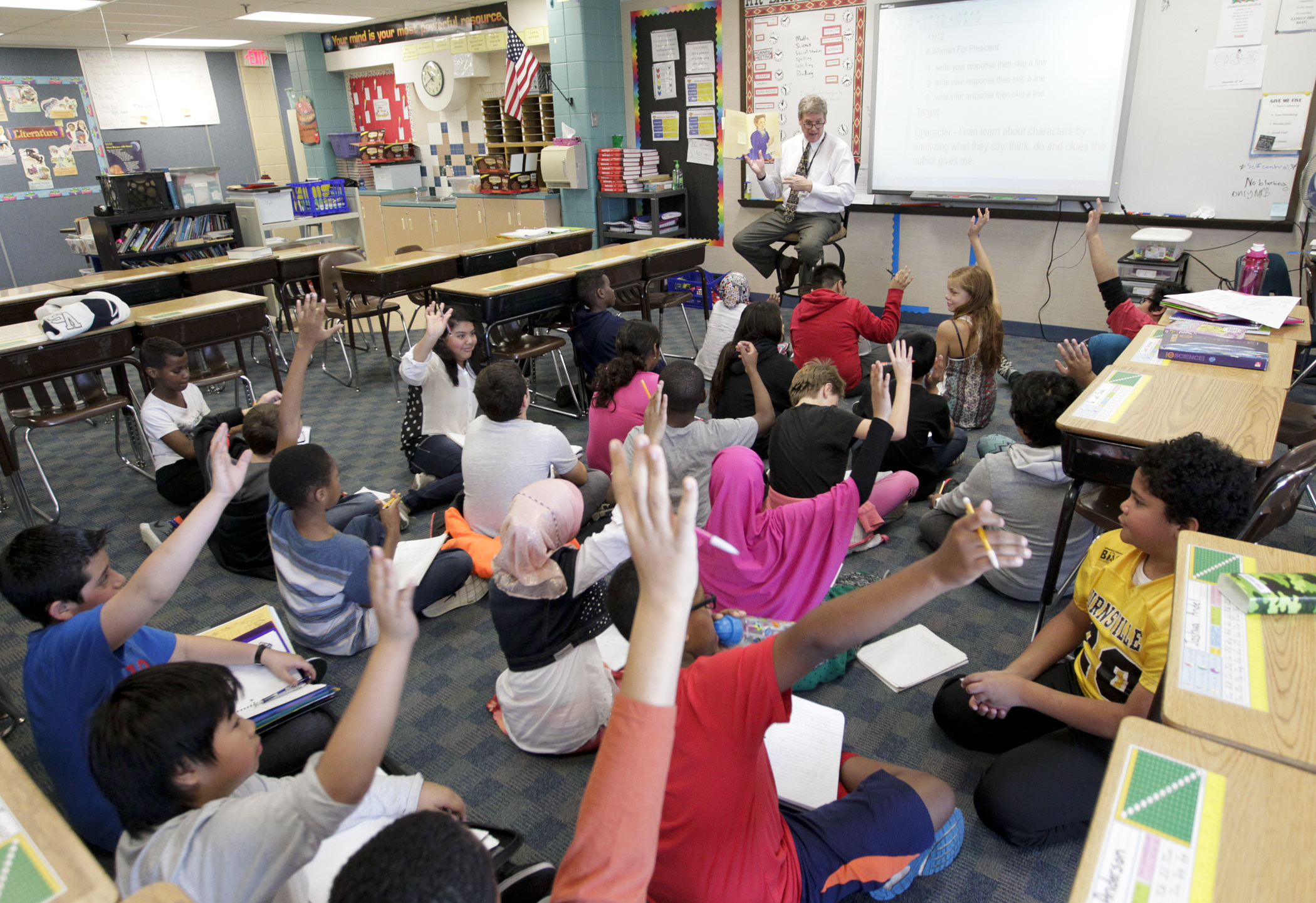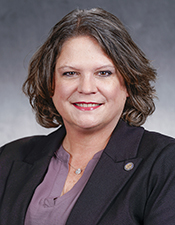DFL unveils K-12 education budget bill that proposes $2.2 billion in new spending on schools

With this proposal, we make historic investments in our schools.
Those were the words of Rep. Cheryl Youakim (DFL-Hopkins), chair of the House Education Finance Committee, while introducing the omnibus education finance bill. The bill calls for $23.2 billion in spending this biennium, which equates to an 11.2% increase over base appropriations.
“We’ve had over 20 years of under-investment in our schools,” Youakim said. “While we cannot change that overnight, or even in one biennium, this is an incredible start.”
She argues the DFL proposal will stabilize school funding, support the health and well-being of students, foster educational equity and innovation, and build up and diversify the state’s workforce.
The price tag comes close to the budget recommendations of Gov. Tim Walz, though his administration sought an additional $470 million in state funding.
The committee held a walkthrough of the delete-all amendment to HF2497 Tuesday and took public testimony Wednesday.
The 314-page amendment combines appropriation amounts, the omnibus education policy bill (with a few revisions noted below), and additional provisions taken from dozens of bills heard during this whirlwind session. Markup and final committee action is expected Thursday.
Let’s get you prepared for that hearing with a look into the current state of the education budget proposal.
Major appropriations
Schools primarily receive state aid via the basic formula – and that funding formula would see a significant boost at a cost of over $700 million. The bill calls for a 4% increase in fiscal year 2024 and a 2% increase in fiscal year 2025, while tying future increases to inflation starting in fiscal year 2026 (subject to a 3% cap).
The special education cross-subsidy, long an albatross around the neck of local districts, would see a huge injection of cash. Almost 48% of this perennial shortfall would be paid by the state annually, up from 6.43% and amounting to nearly $730 million for fiscal years 2024-25. Meanwhile, the English Learner cross-subsidy would be gradually reduced and then disappear completely by fiscal year 2027. The cost this biennium would total $81.8 million.
Department of Education aid for teachers and other school staff clocks in at $360 million, a 45% increase over base spending. Noteworthy items in this bucket include:
- $85 million to hire and train more student support personnel to attend to students’ mental, behavioral, and physical health needs;
- $47 million to nearly triple the investment in Grow Your Own grants, designed to increase the size and diversity of the teaching workforce;
- $20 million to develop a special education teacher pipeline;
- $6 million to revive a dormant teacher residency program, instead of funding a proposed pilot program; and
- $416,000 to cultivate heritage language and culture teachers.
Funding for the department itself would total $84 million, not quite double the previous biennium.
In the wake of the Feeding Our Future scandal, grant-funding oversight would be beefed up via $4 million for a newly established Office of the Inspector General and $1.6 million for auditing resources. Another $4 million would be provided to staff an Equity, Diversity and Inclusion Center and $300,000 would cover the salary of a mental health services lead.
Four thousand pre-Kindergarten seats in jeopardy of disappearing would be permanently installed in the education system, while an additional 5,200 seats would gain funding starting in fiscal year 2025. This expansion of pre-K learning would come at a cost of $85.3 million this biennium.
A $73.2 million allocation would be included to address the festering literacy crisis. This includes $40 million to reimburse districts for the purchase of new curriculum materials and $27.5 million on “evidence-based training on structured literacy” for teachers. Crucially, for those following the session-long debate, the bill does not use the term “science of reading” to describe the new teaching methods.
Funding for American Indian education would nearly double to $60.4 million, covering $37.2 million in general aid, $15 million for native language revitalization grants, and $2.81 million for teacher training grants.
Special education teachers and paraprofessionals would begin to receive compensation for individualized education program prep time, mandatory orientations, and professional development, with $50 million being earmarked for special education instructors and $15.9 million for paraprofessionals.
Local districts would receive $35 million for student safety and cybersecurity measures via the safe schools revenue program, while $27.5 million would be set aside for full-service community school grants, both all-time high funding levels.
Proponents of after-school programming will be very pleased – these programs would be appropriated to the tune of $25 million. However, advocates of equalization proposals to reduce local property taxes will be disheartened as these provisions failed to make the cut (though there is $19.8 million to ensure the bill doesn’t result in any new property taxes).
The final big-ticket item is a substantial increase in transportation sparsity aid. An allocation of $10.5 million would cover 40% of this cross-subsidy, up from the current rate of 18.2%.
Minor appropriations
While the appropriation sum is comparatively small – $3.6 million – the real-world implications are big. The bill would mandate all public schools carry both menstrual products and naloxone (which reverses fatal opioid overdoses), at no charge to students. Other noteworthy sub-$10 million allotments include:
- career and technical education aid would remain flat at $2.3 million but the Rural CTE Consortium would be injected with an additional $4 million;
- $5 million for implementation of the Building Assets, Reducing Risks program at 18 school sites;
- a $4.2 million increase in aid to regional public libraries;
- $3.5 million to train educators on alternatives to exclusionary discipline;
- $3 million in continued funding to the Sanneh Foundation, which was due to sunset;
- $2 million to kickstart construction of gender neutral bathrooms;
- $1 million for computer science education advancement; and
- a bump up of $630,000 for student-led organizations and a $440,000 boost to the education partnership program. The former had their request fulfilled; the latter didn’t even come close.
Notes on the policy omnibus bill
By the start of the 2026-27 school year, schools would have to offer genocide studies and ethnic studies in their social studies curriculum. Meanwhile, students who begin ninth grade in the 2024-25 school year and later would have to complete a half-credit in personal finance to graduate from high school.
Also, the controversial plan to close off the Tier 2 to Tier 3 experience pathway is in the bill, however, current Tier 2 teachers would be grandfathered in.
Miscellaneous
A few last odds and ends that need mentioning:
- 60% of compensatory revenue would have to be allocated at the generating school site and the list of allowable uses for this revenue would be reconfigured;
- language is found throughout the bill indicating the DFL plans to extend unemployment insurance benefits to hourly school workers; and
- both proposed wage and benefit increases for non-licensed school staff and updates to the school nurse staffing law were left out in the cold.
Public testimony
More than 30 individuals, mostly representing advocacy organizations, expressed both gratitude and criticism for the amended bill before the committee, while dozens more submitted written testimony.
The provisions garnering the most approval included increases to the basic formula; reduction of the special education and English Learner cross-subsidies; and the article dedicated to literacy.
Items generating the most disapproval included allowing teacher unions to negotiate class sizes ratios; the curtailment of suspensions for elementary students; and the closing of various licensure pathways.
Finally, three testifiers urged the committee to extend the bill’s ban on seclusion-based punishments up to the third grade, thereby matching language found in the Senate’s education omnibus.
***
What’s in the bill?
The following are selected bills that have been incorporated in part or in whole into the omnibus education finance bill:
- HF8 (Berg)
- HF18 (Wolgamott)
- HF20 (Greenman)
- HF21 (Vang)
- HF22 (Her)
- HF44 (Feist)
- HF58 (Richardson)
- HF180 (Hanson)
- HF193 (Huot)
- HF320 (Hassan)
- HF345 (Hussein)
- HF362 (Moller)
- HF439 (Norris)
- HF456 (Pérez-Vega)
- HF535 (Frazier)
- HF620 (Youakim)
- HF629 (Edelson)
- HF651 (Hassan)
- HF759 (Lee, K.)
- HF806 (Youakim)
- HF877 (Hill)
- HF1175 (Youakim)
- HF1137 (Sencer-Mura)
- HF1269 (Pryor)
- HF1360 (Clardy)
- HF1457 (Pursell)
- HF1502 (Sencer-Mura)
- HF1547 (Feist)
- HF1589 (Bennett)
- HF1691 (Jordan)
- HF1761 (Clardy)
- HF1875 (Keeler)
- HF2042 (Pursell)
- HF2056 (Her)
- HF2214 (Frazier)
- HF2398 (Acomb)
- HF2918 (Pérez-Vega)
- HF2925 (Kozlowski)
- HF2968 (Hornstein)
Related Articles
Search Session Daily
Advanced Search OptionsPriority Dailies
Ways and Means Committee OKs proposed $512 million supplemental budget on party-line vote
By Mike Cook Meeting more needs or fiscal irresponsibility is one way to sum up the differences among the two parties on a supplemental spending package a year after a $72 billion state budg...
Meeting more needs or fiscal irresponsibility is one way to sum up the differences among the two parties on a supplemental spending package a year after a $72 billion state budg...
Minnesota’s projected budget surplus balloons to $3.7 billion, but fiscal pressure still looms
By Rob Hubbard Just as Minnesota has experienced a warmer winter than usual, so has the state’s budget outlook warmed over the past few months.
On Thursday, Minnesota Management and Budget...
Just as Minnesota has experienced a warmer winter than usual, so has the state’s budget outlook warmed over the past few months.
On Thursday, Minnesota Management and Budget...
